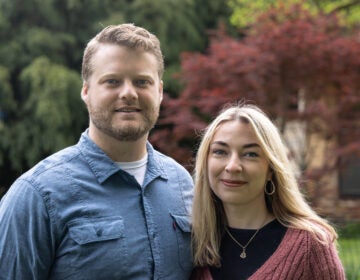Colonial era compass points to Philadelphia’s past
For the first time in a decade, Germantown Historical Society’s Rittenhouse compass is on display, shined up and restored after more than 200 years, with a little help from a friend.
The instrument is thought to be the first compass using the highly accurate vernier scale measurements to compensate for variations in magnetic north. It was created by the famous colonial era astronomer, David Rittenhouse, who was born in Germantown’s Rittenhouse Town along the Monoshone Creek.
The compass has been at the museum since about 1910, and it is thought to have been donated to the society when it began collecting historical Germantown relics in the 1900s. There is no information about who donated it, said Laura Beardsley, executive director at GHS.
“It’s a known relic from our collection since the beginning,” she said.
In the past year, Jeffrey Lock, who specializes in antique restoration, made an appointment to see the compass. He was allowed to study the poorly varnished piece, and in exchange, he offered to restore it for free.
When Lock first saw the compass at Germantown Historical Society, he could see it had been polished at least once in its life.
“This instrument was polished on the upper extremities with shellac or lacquer over it,” he said. “The treatment that they gave it was not at the highest level. It had dripped and sagged.”
He wanted to bring the compass back to its original state.
In December Lock started working on the compass. In May, to avoid shipping the relic through the mail, Mark Sellers, president of the society’s board, and Kristen Froehlich, the director of the collection at Philadelphia History Museum at Atwater Kent, flew out of state in to pick it up.
“We had a beautiful flight. It was a great day,” Foehlich said of the trip in Sellers’ small plain. “Everything that could go right went right.”
They toured Lock’s workspace and then returned to Philadelphia with the compass in a special box.
Laura Beardsley is ecstatic about the final results, which reveal clear signs of wear despite looking decidedly newer.
“It’s very respectful of the object,” she said. “It has a right to age. It’s a well loved, well lived part of our past.”
She estimates the restoration would have cost several thousand dollars, which the museum could not have afforded.
At the beginning of this month, people were invited to see the restored compass in its new inaugural display. It will most likely continue on display until the end of the year, said Beardsley.
A little more help from friends
It’s not the first time the society has received this kind of help. For the second year, Bowman Properties in Chestnut Hill has funded a program to convert old photographs into digital format. Bowman has done about 1,500 pictures so far, which are available online, and it will have about 2,500 at the end of this year, Beardsley said.
But, Beardsley said, there is always a need for this kind of work to keep the collection in good shape.
This was apparent at the Philadelphia Antiques Show in April, where the society’s antique dummy board called “The Turk,” a nearly life-sized painted wood cutout of a person in a turban, was on display next to a similar dummy board cut out of an English soldier called the “The Grenadier,” which is owned by The Philadelphia History Museum at Atwater Kent. Both dummy boards were part of the May 1778 farewell celebration for British General Sir William Howe.
“The Grenadier is sparkly in comparison,” said Beardsley. She thought someday, the historical society will find a way to restore the Turk too, but after more than 230 years, she thinks he can wait a few more.
“[The Turk] is certainly stable and housed to assure his longevity. He’s not in danger of rapid deterioration,” she said.
WHYY is your source for fact-based, in-depth journalism and information. As a nonprofit organization, we rely on financial support from readers like you. Please give today.




